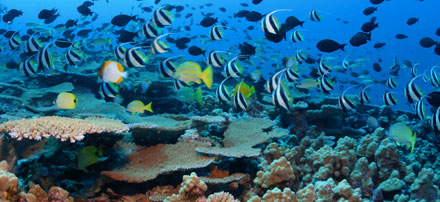|
You
are here: /main/research
expeditions/May 2005/Day 3 Midway
Atoll
Midway
Atoll, Day 3
by Kelly Gleason, Maritime Archaeology Team

Until
this afternoon, we have been blessed with nearly perfect weather
nearly every day. While field operations were still successful
today, by about noontime wind and waves at the atoll had increased
to the point that all of the small boats were recalled to
Hi`ialakai and we ended our work a few hours early. Nevertheless,
the day was extremely successful on many levels and it was
an opportunity to see how well the crew of the ship is able
to operate and retrieve the small boats under rough conditions.
No matter what, they are able to make the complicated task
of lifting an 8 meter jet boat out of the water seem routine
and safe.
This
afternoon, before heading on to Kure Atoll the ship is conducting
multibeam mapping operations in order to add to and fill in
gaps in the information that the mapping team has about Midway
Atoll. Because Midway is a more accessible location than many
of the other atolls in the Northwestern Hawaiian Islands,
there is more data for this atoll, and many scientists are
involved in work analyzing this data in greater depth. For
example, the data collected today at Midway will be used by
a graduate student who is working on modeling the interactions
of currents. As is done at least once a night, the team is
dropping a CTD probe in the water in order to get a sound
velocity profile. Getting acoustical information is important
for the mapping team since sound is the highest source of
error in multibeam mapping. Highly sophisticated sonar systems
such as the one on the Hi’ialakai are sensitive to the
changes in sound velocity. At Midway, an atoll with more activity,
the CTD probe information was critical. For the mapping team,
Kure Atoll is an important target for their work in the Northwestern
Hawaiian Islands. There is very little multibeam data at Kure
Atoll and their work over the next couple of days will fill
in gaps beginning with the one hundred fathom curve, which
will be an important tool for this area.
Today,
the coral team had an exciting morning working out of the
zodiac. They continued to set more permanent transects, and
have made huge contributions over the course of this cruise
towards the establishment of permanent monitoring sites for
coral ecologists. Today’s sites for the coral team were
shallow, something team member Jen Salerno particularly likes
because it means she gets to see more invertebrates during
her work along the transects. The coral team has definitely
found a rhythm in their work and ability to set permanent
transects. Like many of the teams, the first couple of days
of work were challenging as we figured out how to best work
in our small teams. By now, we are familiar with one another
and work is more efficient, and of course, more fun as we
continue to enjoy each other’s company in the field.
For
the fish team, they began their day at a site called the “fish
hole” where photographer John Brooks accompanied them
to take high-definition video footage of fish that are important
species in this region. The hapu`upu`u or Hawaiian grouper
(Epinephelus quernus) and is found at depths of 50
fathoms in the main Hawaiian Islands, far deeper than normal
scuba diving depths. Here in the Northwestern Hawaiian Islands
they are found in much shallower depths in great abundance.
The hapu`upu`u is a Hawaiian endemic, and is found nowhere
else in the world. The knifejaw (Oplegnathus punctatus)
is a southern Japanese fish that is seen in the NWHI but not
in the main Hawaiian Islands. Both are fishes that characterize
the unique fish fauna of the NWHI. Another fish that the team
is interested in collecting while in the Northwestern Hawaiian
Islands is the oval butterflyfish (Chaetodon lunulatus),
which they have been able to locate at spots on the backreef
here at Midway. Feeding exclusively on live coral, the oval
butterflyfish is only found in coral-rich habitats. Studying
the genetics of this and other species can answer important
theoretical questions about the evolution and dispersal of
fish species, and they can also answer practical management
questions regarding fish populations in the Main and Northwestern
Hawaiian Islands.
Leaving
each atoll is always bittersweet. We’re all excited
to visit a new site, and collect more data from another breathtaking
location. However, it also means we’re a little closer
to the end of this cruise, and I don’t think that anyone
on this ship is quite ready for this incredible experience
to be over any time soon.
|